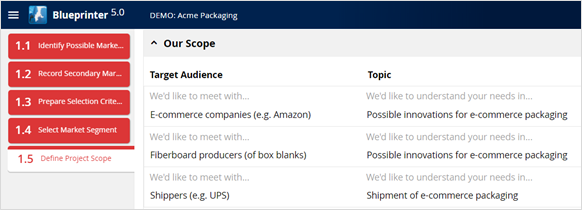Your last step is to name the "topics" you'll discuss in Discovery interviews.
Once your new-product team has selected its target market segment, it can use Blueprinter Tool 1.5: Define Project Scope (at www.blueprintingcenter.com > Blueprinter software) to put “boundaries” around your project. You’ll use this as the “topic” of discussion for your interviews, essentially giving customers free reign to discuss anything within this topic.
Sometimes it’s hard to decide how “wide” or “narrow” your project scope should be. If you make tools or supplies for auto body repair, should your scope be “auto body surface preparation” (narrow), or “auto body repair” (wide). On one hand, if you make the scope too wide, you could spend much of your interview time discussing customer needs that are outside the range of your competencies.
On the other hand, if your scope is too narrow, you could miss important needs that are “adjacent” to your scope… and overlook an exciting opportunity. When in doubt, start your interviews with a wider scope—so you don’t miss these opportunities. You can always narrow your scope in later interviews if your first few interviews guide you to do so. Besides, if you hear a customer outcome during an interview that is clearly outside your area of expertise, you simply don’t have to spend as much time probing it.
In Tool 1.5 you'll select a "Topic"... and you can do this for multiple points in your market's value chain. For instance, you might suggest different topics to those you'd want to interview about corrugated packaging depending on if they were a) a fiberboard blank producer, b) an e-commerce retailer, or c) a package shipper (see below).

Whatever topics you enter above will become available to you in Blueprinter Tool 2.1: Plan Interview Candidates > Prep Sheet > Project Topic.
One last thought: Be flexible with your project scope. It’s entirely possible that your first few interviews will lead you to make a course adjustment. Open-minded teams willing to change their project scope as they learn from customers are usually well-rewarded.
Keywords: project scope, project topic, Blueprinter Tool 1.5, narrow scope, broad scope
